One of the striking aspects of the recently released Telugu film Gaami is its visual aesthetics, with its cinematography playing a significant part. Vishwanath Reddy Chelumalla, who filmed a large part of Gaami (some portions were filmed by Rampy Nandigam), in his first-ever interview, says matter of factly that we are witnessing work that is a few years old since the film was in the making for more than seven years.
Currently, he is learning to use AI (artificial intelligence) tools, armed with the learnings from a ‘prompt engineering’ course for the image generation process. Alongside, he has begun the groundwork for his next Telugu film 8 Vasanthalu, to be directed by Phanindra Narisetti. Earlier, Vishwanath had collaborated with the director for the Telugu indie, Manu.
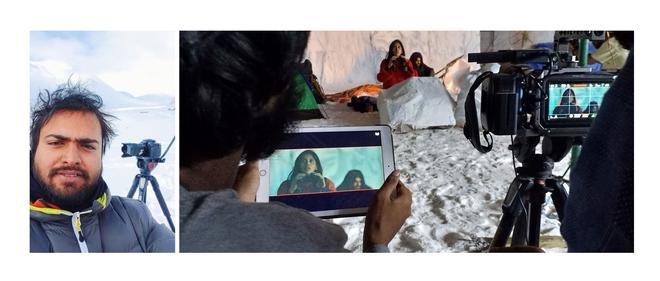
Vishwanath and director Vidyadhar Kagita of Gaami are also long-time collaborators, ever since the former was a wedding photographer and eventually shot the director’s short films Vara and Vaitarani.
If you were piqued by the texture of Gaami, in which some portions appeared calculatedly grainy, it is the result of trying to create the warmth of analogue while filming in digital mode. Research went into choosing the appropriate cameras and lenses for the terrains and weather conditions befitting the three stories in the film.
Vishwanath Reddy filmography
Cameras used for Gaami
The origin story
“Until now, I never wanted to talk about myself or my work because I wanted to do something substantial,” says Vishwanath, during this interview at the UV Productions office in Hyderabad. Before discussing the intricacies of Gaami, he recalls his early years in Karimnagar. “My parents were teachers at a government school and we had no connections with the film industry.” He pursued B.Tech before branching out to do wedding photography. He also took up a diploma course in visual effects.
It all began when his parents gifted him a Kodak point-and-shoot camera when he was in Class VII. “I did not understand photography but enjoyed playing around with the gadget.”
Vishwanath grew keen on photography sometime in 2009. He would shoot landscapes, macros and anything that did not involve people. “I was shy to talk to people and did not take portraits.” Once, former President of India APJ Abdul Kalam visited the campus (J B Institute of Engineering and Technology, Moinabad) and a friend encouraged him to take photographs. A usually shy Vishwanath made his way through the crowd and took a few photographs of Kalam. It was a start. By 2015, Vishwanath had become a seasoned wedding photographer, capturing different moods of people. He had left B.Tech midway, with 21 backlogs, and it was wedding photography that gave him financial stability.
The collaborations
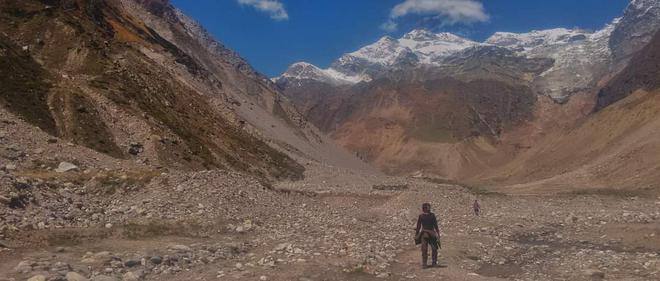
At a wedding, he met Vidyadhar and the two hit it off. “In the off-season when there were no weddings, I had the scope to do something else,” says Vishwanath. The duo began working on short films, many of which are not available in the public domain. “We would make shorts for contests such as 48 Hour Film Project and Done in 60 Seconds. When we begin a film, we never look at it from the point of view of whether it would generate views and appeal to people. We thought we should like our work to begin with.” Vara and Vaitarani are two of their short films, available on YouTube.
With his interest in cinema growing, Vishwanath applied to a film school in Canada and got a scholarship. Before he could take it up, he was approached by Phanindra Narisetti for Manu.
Emulating film
Soon, Gaami followed. “Initially, Vidyadhar wanted three DoPs (director of photography) to film the three stories but later he became confident that I could do it. He wanted a commitment of three to four years and I was game, since I liked the concept.”
For Gaami, he and Vidyadhar wanted on-screen textures similar to that of shooting on film. Vishwanath cites the 2018 Hollywood film First Man as a reference for the texture they aimed for. However, shooting in film is an expensive proposition today. Film buffs would recall that closer home, portions of Mahanati were shot on film. “While using digital, we had to figure out a way to emulate Kodak 2383 print film emulation to allow the VFX shots to blend in and be aesthetically appealing. We studied different grain structures and colour responses by using the Look Developer tool and Baselight Vision film look,” he explains.
Vishwanath also cites an example of how Dune 1 was worked upon by director of photography Greig Fraser. “Theirs was a complex process involving printing digital footage to film, re-scanning it and doing a digital grade on it.”
Avid movie buffs would also be aware that Christopher Nolan prefers analog over digital. He shot major portions of Interstellar, Dunkirk, Tenet and Oppenheimer using IMAX film cameras.
For an indie Telugu film, such processes are expensive and out of reach. They had to find ways to get the desired output with limited resources.
Large format
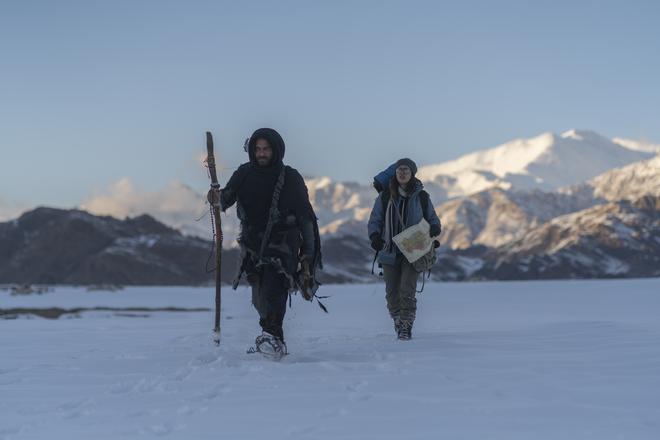
Vidyadhar and Vishwanath, along with the visual effects supervisor Sunil Chinta, began working on the pre-visualisation process. They were also keen to offer the Telugu audience a large format viewing experience — at Prasads PC-X large screen in Hyderabad and V EPIQ in Nellore. They did not want to merely extend the visuals horizontally for these large screens. “We wanted the audience to feel like they are on location and see the vast Himalayan landscapes. We wanted the visuals to have height and depth.”
He explains that Gaami was filmed in the aspect ratio of 16:9 to suit regular screens; for large screen formats, visual effects extensions and matte paintings were carried out for some of the Himalaya portions. Tests were carried out at Prasads multiplex large screen in Hyderabad.
On ground ‘Gaami’
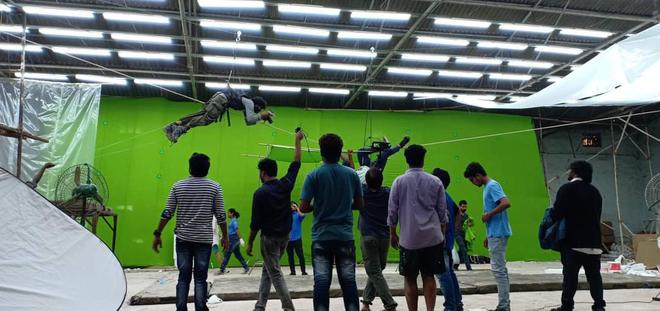
Gaami went on floors with a schedule in Nellore — where the story of MG Abhinaya and Harika Pedada was filmed — when it was a sweltering 40 degrees. The earthy landscape was complemented by the warm colour palette, further accentuated by the ‘sun guns’ (a light source that replicates natural sunlight) at their disposal. “These were the lights I would use for wedding photography,” laughs Vishwanath.
After the Nellore schedule, the team filmed in Varanasi and Prayagraj during the Kumbh Mela. However, a few scenes were also filmed in Hyderabad and made to appear as though shot in these locations.
Vishwanath discloses that even before production designer Pravalya Duddupudi came on board, assistant director Arvind had helped design the interiors of the Ayurvedshala (remember an early scene when a guru identifies Vishwak Sen as Shankar?). “The tent and its interiors were designed on the rooftop of our producer Karthik Sabareesh’s office!” If the visual palette never made the audience discern that this was a set on the rooftop of a building in Hyderabad, the credit would go to the production design and cinematography team.
“We did a lot of jugaad,” adds Vishwanath. For instance, for a shot that involved shadowy movements created by fire that had to reflect on Vishwak Sen, assistants used steel plates in specific motion to create the desired effect.
A 6000-square-foot godown was taken on lease to design sets and film the green screen shots to which the visual effects were added later. Some of the scenes that involve Vishwak Sen and Chandini Chowdary walking on ice or scaling the mountains were shot in Hyderabad.
On the mighty Himalayas
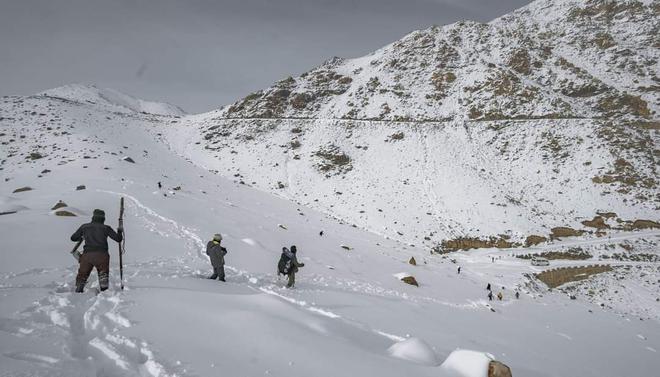
During an extended schedule on the snow-capped mountains, the temperatures dipped to minus 35 degrees Celsius. The small crew travelled in a tempo, carrying hot water, warmers and oxygen cylinders. While filming near Khardung La, both Vishwanath and Chandini had briefly fallen ill, with their oxygen saturation dipping below 75% and were rescued in time by the Indian Army personnel. “They asked us not to be adamant about filming in such weather conditions. They told us about another crew that was filming a documentary and later could not be traced. From then on, we filmed in areas closer to Army camps.”
An avalanche in Ladakh ensured that they could film in the heavy snow conditions that they wanted for the film. The frozen Zanskar river also turned out to be an unexpected shooting spot. In a scene in Gaami, an Army officer asks Chandini what use her permits and high-profile connections are in inclement weather. It was similar to when the crew had gone to film in Ladakh. “Each day we faced a new challenge and our plan of filming in 15 days extended to 28. We completed all the shots involving the actors.”
Working with a small crew meant not having a dedicated focus puller and Vishwanath doubling up to do the job. Preventing frostbite was easier said than done and he shows a large scar that refuses to heal. He also recalls the team having to hike up a mountain to retrieve a drone that had crashed. “The locals warned us against going uphill but we had to find the drone.”
The arsenal
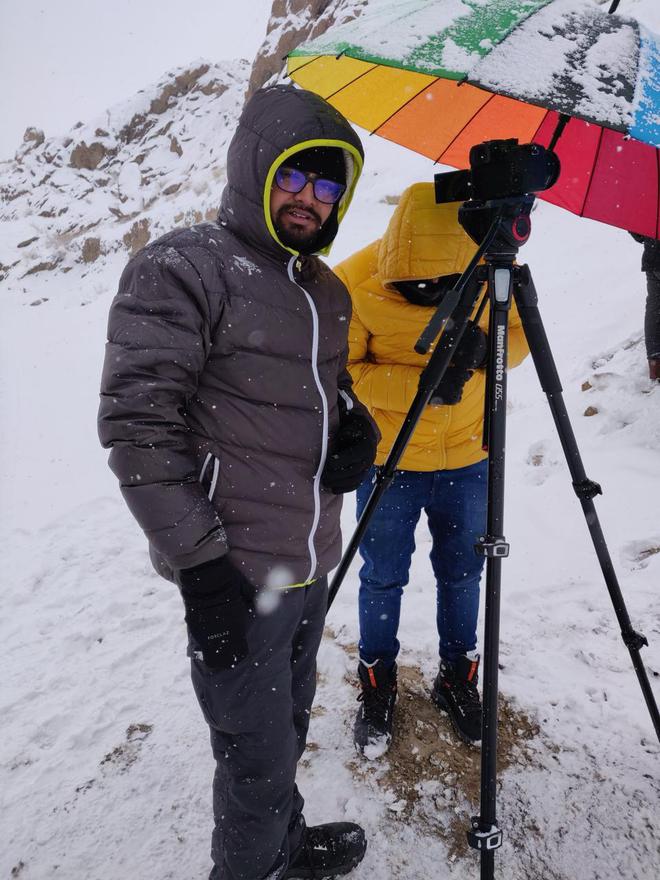
Vishwanath reveals that only the Panasonic GH5S camera was conducive to film in the heavy snow conditions. “After 20 to 30 minutes, most other cameras would automatically shut down and the battery would show zero.” He cites the example of how Panasonic LUMIX GG5 supported polar explorer Yasunaga Ogita in Japan’s first solo south pole expedition without resupplies.
There was also the challenge of recreating certain light conditions of the Himalayas in Hyderabad for visual effects. “When the snow surface reflects natural light, the brightness is of high intensity and can cause snow blindness. During breaks, I would gaze at the sky rather than look below. To recreate such light in Hyderabad (for a green screenshot that would later be worked upon by VFX), we used 600 LED tube lights and a 72kv generator.”
As Gaami took longer than anticipated to complete, Vishwanath was approached by other film units for projects and he turned down 16 of them. “After a point, I realised that I had to take up something to avoid the word spreading in the industry that I always turn down projects,” he says. He mentions that Vidyadhar was generous enough to let him go and Rampy Nandigam stepped in to film portions of the illegal medical facility.
Next up, Vishwanath is looking forward to film 8 Vasanthalu and taking up new films that would give him a different set of challenges.







